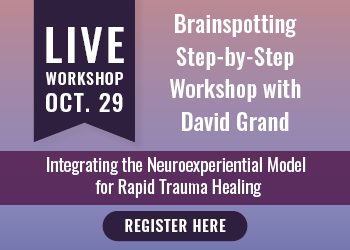Workshop Schedule (Eastern Time)
- 9:00 - 9:15: Opening introduction
- 9:15 - 10:15: PowerPoint on foundations of Brainspotting
- 10:15 - 10:30: Break
- 10:30 - 11:15: Demonstration - Outside Window
- 11:15 - 11:30: Debrief Demonstration - Outside Window
- 11:30 - 12:30: PowerPoint on models of Brainspotting
- 12:30 - 1:30: Lunch
- 1:30 - 2:15: Demonstration - Inside Window
- 2:15 - 3:00: Debrief Demonstration - Inside Window
- 3:00 - 3:15: Break
- 3:15 - 3:45: Group exercise of Gazespotting and debrief
- 3:45 - 4:15: Resource model of Brainspotting
- 4:15 - 5:45: Neuroexperiential model of Brainspotting - PowerPoint and discussion
- 5:45 - 6:00: Conclusion of workshop
Outline
- What is Brainspotting and how does it relate to trauma recovery
- How eye position can help heal trauma
- The Brainspotting Model
- Core Principles and the clinical application of Brainspotting
- Integrating Brainspotting into your practice
- Risks and Limitations
- Demonstrations
Objectives
- Understand how eye positions have relevance in potentially accessing and healing frozen trauma in the brain.
- Describe the role of therapist in a Brainspotting session, demonstrating an understanding of its significance to the “dual attunement” frame.
- Understand how the client brings to session a frame of their experiences that the therapist recognizes, receives and holds with them.
- Evaluate the empirical evidence supporting Brainspotting therapy as an effective treatment intervention for post-traumatic stress disorder (PTSD).
- Discuss how the mutually held frame produces focused mindfulness processing that supports the innate human capacity for self-healing.
- Summarize how developmental trauma yielding symptomatic manifestations is inaccurately labeled as disordered.
- Demonstrate a basic mastery of the use of the inside and outside window brainspotting technique.
Target Audience
- Counselors
- Social Workers
- Psychologists
- Marriage and Family Therapists
- Addiction Counselors
- Other Mental Health Professionals


